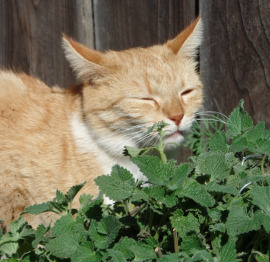 Catnip has been a favourite treat among cat owners for generations. In fact, catnip was quite commonly used in medieval times for herbal medicines, cooking, and to liven up house cats and barn cats.
Catnip has been a favourite treat among cat owners for generations. In fact, catnip was quite commonly used in medieval times for herbal medicines, cooking, and to liven up house cats and barn cats.
Many cat owners express concern about this mysterious herb, and question the potential psychological effects of catnip exposure. Let’s break it down.
What is Catnip?
Catnip, often referred to as catswort or catmint, is a natural perennial herb that can grow up to three feet in height. In the wild, catnip can be found in most parts of southern and eastern Europe, India, and Asia. However, because it is considered an aggressive grower, catnip has been mostly eradicated in North America.
The technical term for catnip is Nepeta Cataria. It blooms from late spring until autumn, has green-brown, triangular leaves, and resembles wild mint. When in bloom, catnip has small pink or white flowers, and pale purple spots. It is also quite fragrant, making it easy to discern. In North America, catnip is either farmed, or grown in greenhouses.
How Does Catnip Affect Cats?
The chemical compound in catnip that affects cats is called nepetalactone. It can affect felines in two different ways: when ingested, it can have calming and sedating effects, whereas cats who smell it can experience psychoactive effects and hyperactivity.
Surprisingly, only about two-thirds of cats will experience the effects of catnip. This explains why, in some households, certain cats love catnip, and others completely ignore it.
In order to experience the effects from smelling catnip, cats will often roll on it, rub it, lick it, chew it, or paw at it. These acts break the stems and bruise the leaves, leading to the release of nepetalactone. This chemical triggers and binds to olfactory receptors, causing your cat to feel a sense of euphoria thought to be similar to marijuana. The high may last for up to fifteen minutes. In young kittens, specific receptors in the brain are not fully developed yet, which is why cats do not feel catnip’s effects until reaching adulthood.
Cats who chew and consume too much catnip, rather than rubbing and smelling it, may become drowsy, may drool, and may also purr more. For a small minority of cats, catnip exposure may cause restlessness or anxiety, so use it with supervision. If your cat consumes a very large volume of catnip, they may experience vomiting and diarrhea. Try introducing catnip to your kitty in small amounts and see how well it is received. Catnip is very safe for cats, and does not have any long-term negative effects.
With prolonged exposure, cats may develop a tolerance to catnip. If it is something they are given regularly, the effects will lessen. To prevent this from happening, it is recommended to only give your cats catnip a few times a month, but it won’t hurt to have it available more often.
Are there alternatives to catnip?
While many cats are uninterested in or unaffected by catnip, there are also a few alternative herbs available. Valerian root and leaves have been a popular cat attractant for centuries, as has tatarian honeysuckle. Silver vine, also known as matatabi, is currently the most popular cat attractant in Asia. Cats who don’t respond to catnip are highly likely to respond to one of these three alternatives.
Catnip is a safe and fun alternative to food-based treats, and can keep your cats entertained for quite a while. It comes in the form of loose-leaf catnip, and can also come packed into fun pouches or toys. Many consumables, like treats and supplements also contain catnip. The key is to use catnip sparingly, and make sure you supervise your cat to avoid any bad experiences. If your cat shows negative effects, such as anxiety, it is best to avoid catnip in the future. To liven up your cat’s day, try one or more of the following:
-
Stuff an old sock with catnip and tie the end off.
-
Roll existing toys in loose catnip.
-
Sprinkle catnip on and around scratch posts and beds.
-
Hide catnip underneath objects.
-
Catnip scavenger hunt!
Overall, catnip is widely enjoyed by domesticated felines, and it is rare to experience any negative effects from exposure. Catnip can be used as a bonding tool between you and your cat. There are all sorts of fun games and activities you can do together, which will only further your bond. Or, simply use it for added stimulation, to keep your cat entertained.
Brandon Forder – also known as The Pet Expert – is vice-president of Canadian Pet Connection, a family-owned and -operated business located in Meaford. He has over twenty-five years’ experience specializing in pet nutrition, behaviour, and healthy pet lifestyles. Canadian Pet Connection is an industry leader committed to providing their clients with the highest levels of personal, attentive service. Learn more at www.CanadianPetConnection.ca.










